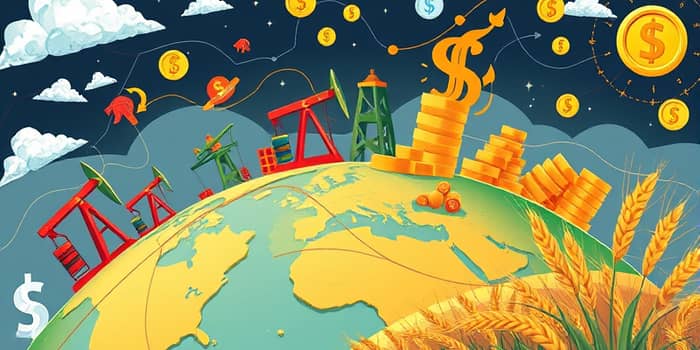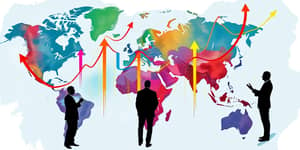In a world defined by rapid technological advances and shifting geopolitical alliances, commodity markets serve as the bedrock of the global economy. From the grain that fills our tables to the metals that power smartphones, raw materials influence every facet of daily life. The disruptions of recent years — from pandemic-driven supply shocks to inflation surges and trade disputes — have underscored the fragility and resilience of these markets. As we step into 2025, understanding the forces that shape commodity trends is crucial not only for investors but also for businesses, policymakers, and communities worldwide.
The journey of commodity prices over the past three years has been a roller coaster. A dramatic 16% rally during the 2022 inflation outbreak gave way to modest gains and ultimately a broad price decline in 2024. Analysts now forecast that global commodity prices may dip to their lowest levels in six years by late 2025. Yet beneath the headline numbers lie nuanced opportunities and risks that demand a careful and informed approach.
Commodity Market Fundamentals
Commodities are raw materials traded in standardized units on global exchanges. They can be categorized broadly into four groups: energy (oil, natural gas, power), metals (precious and industrial), agriculture (grains, softs), and livestock. Each category responds differently to economic cycles, policy interventions, and environmental factors.
Over the last century, technological innovation and productivity improvements have driven a long-term decline in real agricultural prices. Farmers have adopted precision agriculture, improved seed genetics, and advanced irrigation, leading to record yields. In contrast, energy commodities have trended upward in real terms, influenced by growing global consumption and geopolitical complexities in oil-producing regions.
Commodities also serve as tangible hedges against inflation. When paper currencies lose purchasing power, physical assets like gold or oil often retain value. Additionally, many emerging market economies rely on commodity exports for fiscal stability and social programs, linking raw material prices to broader development goals.
Macro Factors Influencing Commodities
The trajectory of commodity prices is shaped by three primary macroeconomic forces:
- Periods of persistent high inflation elevate raw material costs and can boost commodity values.
- Strength or weakness of the U.S. dollar influences global purchasing power and export competitiveness.
- Undersupplied physical commodity markets entering 2025 reflect years of underinvestment in production capacity.
Inflation in major economies has proven “sticky,” with the U.S. rate hovering near 3% even as central banks tighten monetary policy. Commodities historically perform well in such environments as investors seek assets that retain real value. However, sharp rate hikes can dampen demand by increasing borrowing costs for consumers and businesses.
Meanwhile, the U.S. dollar’s strength acts as both a refuge and a headwind. A robust greenback makes dollar-denominated commodities more expensive for foreign buyers, potentially suppressing demand. Conversely, a softer dollar would provide immediate relief to importers and could spur price rebounds.
After years of insufficient investment in new capacity, many commodity sectors are entering 2025 with tight supply pipelines. Companies delayed expansion amidst low prices, rising interest rates, and regulatory uncertainties. This undersupplied market environment may prime prices for sudden spikes if demand unexpectedly rebounds or disruptions occur.
Geopolitical and Policy Risks
The interplay between geopolitics and commodity markets has never been more evident. Conflicts in the Middle East, sanctions on key producers, and the rise of economic nationalism contribute to supply volatility. Energy commodities, in particular, react sharply to tensions in oil-producing regions, where any escalation can trigger fear-driven buying and price surges.
Trade relations between the United States and China remain a critical wildcard. Tariff threats and policy clashes can throttle industrial demand, especially for metals like copper, aluminum, and steel. On the flip side, any easing of trade barriers or fresh stimulus in China could reignite commodity consumption and drive prices upward.
OPEC+ decisions on production cuts or increases continue to command global attention. While some member countries push for higher output to shore up revenues, others advocate supply restraint to support prices. This delicate balancing act underscores the ongoing geopolitical instability and volatility that marks the energy sector.
Outlook and Forecasts for 2025
Consensus forecasts suggest a continued moderation in commodity prices, with many benchmarks trading near multi-year lows. Yet within this broad trend, distinct sectoral narratives emerge, providing both caution and opportunity:
For investors and businesses, the key is to identify sub-segments that offer the right risk-return profile. Precious metals may serve as a defensive play, while certain agriculture markets could rebound if weather anomalies disrupt production. Energy remains highly sensitive to geopolitical developments and policy shifts toward renewable energy.
Long-Term Structural Shifts
The global drive toward decarbonization is reshaping commodity demand at a fundamental level. The shift from fossil fuels to renewables is spurring unprecedented consumption of metals like copper, lithium, nickel, and cobalt — all crucial for battery storage and electric vehicles. This green energy transition shaping demand heralds a new era in resource allocation.
Simultaneously, emerging market and developing economies (EMDEs) are exerting growing influence. Nations in Asia, Africa, and Latin America are urbanizing rapidly, fueling demand for steel, cement, and energy. This transition underscores the rising importance of emerging markets driving future consumption and the need to tailor strategies to localized trends and policies.
Technological advancements such as digital trading platforms, blockchain verification, and precision mining are improving transparency and efficiency. These innovations are helping market participants manage logistics, reduce fraud, and align operations with environmental and social governance (ESG) standards.
Risks and Uncertainties for Investors
No forecast is without uncertainty. Key risks include:
- New trade tensions or additional tariffs that could depress industrial demand.
- Severe weather events and climate anomalies causing sudden supply disruptions.
- Regulatory changes, such as stricter environmental rules that raise extraction costs.
- Market sentiment-driven swings that can trigger rapid re-pricing of assets.
To navigate these uncertainties, investors should:
- Diversify across different commodity classes and geographies.
- Employ hedging strategies to mitigate price and currency risks.
- Monitor policy developments in major economies closely.
- Stay agile, ready to adjust positions in response to emerging data.
Conclusion: Navigating the Path Ahead
The journey through the commodity landscape in 2025 and beyond will be defined by a balance of cyclical forces and structural transformations. While forecasts signal a moderation in prices, opportunities abound for those who understand the underlying dynamics and remain vigilant to change.
By grounding decisions in data, embracing sustainability trends, and preparing for volatility, stakeholders can turn uncertainty into a catalyst for innovation and growth. In the ever-evolving world of raw materials, knowledge, adaptability, and strategic foresight are the keys to success.
As you incorporate these insights into your strategies, remember that commodity markets are more than just numbers and charts — they are reflections of human ingenuity, policy choices, and the planet’s finite resources. With this perspective, you are equipped to chart a course that contributes to both economic resilience and a sustainable future.
References
- https://www.worldbank.org/en/research/commodity-markets
- https://www.morganstanley.com/im/en-gb/intermediary-investor/insights/articles/commodity-outlook-2025-three-areas-to-watch.html
- https://globalmarkets.cib.bnpparibas/commodity-markets-energy-markets-2025/
- https://tradingeconomics.com/forecast/commodity
- https://www.parametricportfolio.com/blog/commodity-outlook
- https://www.oxfordeconomics.com/resource/five-key-commodity-trends-to-watch-for-in-2025/
- https://flow.db.com/trade-finance/commodities-outlook-for-2025-prices









